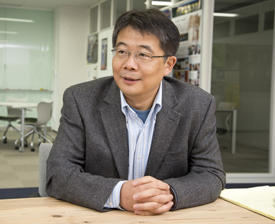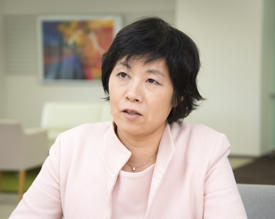

12/20/2013
The mathematics-driven approach to materials science research at the AIMR is a distinguishing feature of the institute’s research culture and sets it apart from the other institutes in the WPI program. Although still at an early stage, the strategy has already produced a number of exciting results. AIMResearch spoke to Mingwei Chen, a principal investigator in the Bulk Metallic Glasses Group, and Motoko Kotani, director of the AIMR and a principal investigator in the Mathematics Unit, about their collaborative work which was the subject of a recent Science paper.

AIMResearch: Your recent paper — entitled “Geometric Frustration of Icosahedron in Metallic Glasses” — is an excellent example of mathematics-driven materials science research. How would you summarize the paper’s main findings?
Chen: Our work presents conclusive evidence showing that metal atoms pack into the glass state as geometrical fluctuations of 20-faced units called icosahedrons. This had previously been suggested, but we combined experimental results with extensive modeling and simulation to confirm that this motif could be used to make theoretical predictions of long-range disorder in metallic glass systems.
To understand structure–property correlation in metallic glasses, we need to work on the atomic scale because, unlike crystalline materials, glasses do not have a clearly defined microstructure, such as grain or defects. This is extremely challenging because glasses essentially consist of long-range disorder. Uncovering the atomic arrangement of glasses helps us to gain insight into fundamental processes such as the liquid to glass transition, the formation of shear transformation zones — the movement of atoms when force is applied — and the breaking of atomic bonds and failure of the glassy material. The work in our latest Science paper1, which follows our 2011 paper in Nature Materials2, establishes local structural features such as the geometrical and topological atomic arrangement and shows how these are distorted in the glass state.
AIMResearch: Your discovery was achieved by combining experiment, theory and mathematical modeling. What respective roles did these play in the research?
Chen: As you might expect, technical aspects were extremely important in this work, and, in particular, the angstrom-beam electron diffraction method. This technique uses a modified transmission electron microscope to precisely focus a coherent electron beam of about 3 angstroms in diameter, without which we would never have been able to observe the local atomic arrangement of the sample. This is the first technique that allows us to image not only metallic glasses but also oxide glasses and other disordered systems in such detail.
Kotani: A major part of the work involved translating the experimental data into a picture of the overall structure of the metallic glass. This issue was addressed by Akihiko Hirata (associate professor in the Bulk Metallic Glasses Group) and Kaname Matsue (assistant professor in the Kotani Laboratory) who used advanced topological methods to derive a global structure from local structural data using a modeling program provided by the Computational Homology Project (CHomP).
This web-based software provides non-mathematicians with a relatively pain-free way to analyze complicated datasets using topological techniques. As a result, many researchers at the AIMR have become interested in using topology to get essential data from complex figures and hierarchies for working on glassy and nanoporous materials.

AIMResearch: The scientific value of this research is very clear. What is its significance in terms of the mathematics-driven materials science agenda that has been adopted by the AIMR?
Kotani: When we proposed the new mathematics–materials-driven research approach, many thought it was an attractive idea but also very challenging. What that really means is that they thought the strategy was rather high risk. I always believed that the direction we chose was the correct one but did not expect that we would get concrete results so quickly. While I think we are yet to make a real breakthrough, results like those in Professor Chen’s paper give us confidence that our research program is moving in the right direction.
Chen: I agree that it is important to have been able to prove the concept of combining mathematics with materials science in such a short time. As an experimentalist, I can say that working collaboratively like this has not only given us a tool for research, but has also changed our conceptual viewpoint and opened my eyes to a new research philosophy. Taking a more fundamental approach, such as looking at the topological interpretation of the system, has helped to keep our minds on the bigger picture, as well as on the details.
AIMResearch: How do you expect the current collaboration to develop?
Chen: We believe that there is a common link between the behavior of all types of glassy materials and we are working to apply our methods to other systems such as polymer and oxide glasses, as well as chalcogenide glasses. Using theoretical models derived from experimental data, we can eventually begin to design materials with enhanced properties.
Kotani: Gaining a comprehensive understanding of glassy substances is one of the main areas of work at the AIMR. In the future, we will concentrate on establishing a universal framework for these systems. Glassy materials exist at a phase interface between particle dynamics, which obeys certain mathematical rules, and continuum dynamics, which can be described using tools such as Navier–Stokes equations. At the moment we do not have a master equation that describes these phenomena, so developing a mathematical theory that can handle these areas is a big challenge.
AIMResearch: How did the research environment at the AIMR help to make this discovery?
Chen: One important reason for the success of our study is the way in which the WPI program has fostered real fusion research that, in the case of the AIMR, puts mathematicians in the same building as experimentalists like me. This gives us the opportunity to discuss research directly, rather than having to travel to different campuses, and to establish working relationships with the right people, straight away.
Kotani: I am also very grateful to the WPI program for giving us the opportunity for this kind of interaction and support. It allows us to physically meet with the best people to discuss problems on a daily basis, which would not be possible under any other system. The same commitment to exchange has allowed us to set up the Interface Unit, which provides a bridge between young independent researchers in mathematics and experimentalists. The system has really stimulated our young academics and has provided a model that is being considered for roll out across Tohoku University. As is apparent, this is a very exciting time to be researching mathematics and materials science at the AIMR.